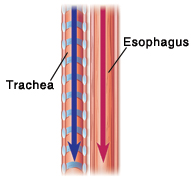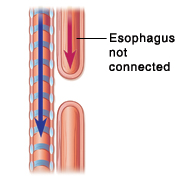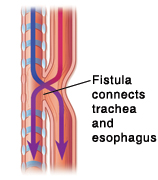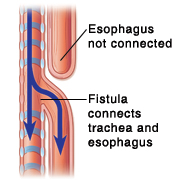Tracheoesophageal Fistula and Esophageal Atresia in the Newborn
Tracheoesophageal Fistula and Esophageal Atresia in the Newborn
The esophagus (food pipe) and trachea (windpipe) are 2 separate tubes. The esophagus runs behind the trachea inside the chest. Both of these tubes start at the throat. The food you eat travels down the esophagus into the stomach. The air you breathe travels down the trachea into the lungs. In some babies, these tubes don’t form correctly during pregnancy. This can lead to the problems described below. Your baby might have one or both of these problems.
In normal anatomy, the trachea connects to the lungs. The esophagus connects to the stomach. |
With esophageal atresia, the esophagus doesn’t attach to the stomach. Food can’t reach the stomach. |
With tracheoesophageal fistula, the trachea and esophagus are connected. Air can go into the stomach, and food can go into the lungs. |
With this combination of fistula and atresia, air goes into the stomach and the lungs. Food can’t reach the stomach. |
What is tracheoesophageal fistula?
A tracheoesophageal fistula (TEF) is an abnormal opening between the trachea and the esophagus. During pregnancy, the baby’s trachea and esophagus start out as one tube. During the first trimester, they are supposed to separate into 2 tubes. If the wall of tissue between the trachea and esophagus doesn’t form fully, an opening between the 2 tubes remains. This is a fistula. When the baby eats, food can pass from the esophagus through the fistula into the trachea. This can cause breathing problems. Symptoms of TEF include coughing and difficulty breathing that worsens when feeding.
What is esophageal atresia?
Esophageal atresia (EA) occurs when the esophagus doesn’t attach to the stomach; therefore, food can’t get from the esophagus into the stomach. The main symptoms of EA include vomiting and drooling.
How are the problems diagnosed?
If your baby has problems eating or breathing, chokes during feeding, or coughs up a lot of fluid or mucus, he or she may have TEF or EA. Your health care provider will take an X-ray to learn more. This will show if the baby has one or both problems. The X-ray is often done with a feeding tube put into the baby’s esophagus to see if the tube reaches the stomach.
How are the problems treated?
Both of these problems require surgery. In many cases, a feeding tube is put into the baby's stomach to give nutrition. In other cases, your baby may receive nourishment through an IV (intravenous) line until surgery can be done. A breathing machine may also be needed:
To treat TEF, the opening between the trachea and esophagus is closed during surgery.
To treat EA, the esophagus is connected to the stomach. In some cases, a tube with a weighted tip is put into the esophagus. This helps stretch the tissues to reach the stomach. It may take a few weeks before the esophagus is long enough to reach the stomach. The baby will probably stay in the neonatal intensive care unit during this time. When the esophagus is long enough, surgery is done to attach it to the stomach.
What are the long-term effects?
Treatment of TEF often has a good outcome. Once the fistula is closed, many babies don’t have problems. But in some cases, ongoing breathing problems can occur.
EA can cause more serious problems. If the esophagus must be stretched, your baby may have permanent swallowing problems. Many babies develop GERD (gastroesophageal reflux disease). Also, your baby may have been fed through an IV until after treatment. As a result, your baby may have trouble moving on to breast or bottle feedings. For instance, your baby may have trouble learning how to suckle and breathe at the same time. The healthcare provider can tell you more about how your baby is likely to progress.
A narrowing (stricture) can occur in the esophagus from scar tissue.
Updated:
September 30, 2017
Sources:
Congenital anomalies of the intrathoracic airways and tracheoesophageal fistula. UpToDate., Current Knowledge on Esophageal Atresia. Pinheiro, M, Fernando, P. World Journal of Gastroenterology. 2012;18(28):s3662-72., Endotracheal tube management and complications. UpToDate., Predictive factors for complications in children with esophageal atresia and tracheoesophageal fistula. Shah R. Diseases of the Esophagus. 2015;28:216–223., Prenatal diagnosis of gastrointestinal atresia and obstruction. UpToDate.
Reviewed By:
Freeborn, Donna, PhD, CNM, FNP,Lehrer, Jenifer, MD



